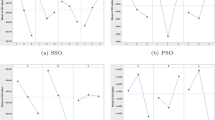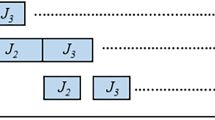Abstract
This study addresses a resource-constrained unrelated parallel machine scheduling problem with machine eligibility restrictions. Majority of the traditional scheduling problems in parallel machine environment deal with machine as the only resource. However, other resources such as labors, tools, jigs, fixtures, pallets, dies, and industrial robots are not only required for processing jobs but also are often restricted. Considering other resources makes the scheduling problems more realistic and practical to implement in manufacturing environments. First, an integer mathematical programming model with the objective of minimizing makespan is developed for this problem. Noteworthy, due to NP-hardness of the considered problem, application of meta-heuristic is avoidable. Furthermore, two new genetic algorithms including a pure genetic algorithm and a genetic algorithm along with a heuristic procedure are proposed to tackle this problem. With regard to the fact that appropriate design of the parameters has a significant effect on the performance of algorithms, hence, we calibrate the parameters of these algorithms by using the response surface method. The performance of the proposed algorithms is evaluated by a number of numerical examples. The computational results demonstrated that the proposed genetic algorithm is an effective and appropriate approach for our investigated problem.











Similar content being viewed by others
References
Alavidoost, M. H., Fazel Zarandi, M. H., Tarimoradi, M., & Nemati, Y. (2014). Modified genetic algorithm for simple straight and U-shaped assembly line balancing with fuzzy processing times. Journal of Intelligent Manufacturing. doi:10.1007/s10845-014-0978-4
Alcan, P., & BaşLıGil, H. S. (2012). A genetic algorithm application using fuzzy processing times in non-identical parallel machine scheduling problem. Advances in Engineering Software, 45(1), 272–280.
Arnaout, J.-P., Musa, R., & Rabadi, G. (2014). A two-stage Ant Colony optimization algorithm to minimize the makespan on unrelated parallel machines—part II: Enhancements and experimentations. Journal of Intelligent Manufacturing, 25(1), 43–53.
Bilyk, A., & Monch, L. (2012). A variable neighborhood search approach for planning and scheduling of jobs on unrelated parallel machines. Journal of Intelligent Manufacturing, 23(5), 1621–1635.
Çakar, T., Köker, R., & Demir, Hİ. (2008). Parallel robot scheduling to minimize mean tardiness with precedence constraints using a genetic algorithm. Advances in Engineering Software, 39(1), 47–54.
Centeno, G., & Armacost, R. L. (1997). Parallel machine scheduling with release time and machine eligibility restrictions. Computers and Industrial Engineering, 33(1–2), 273–276.
Centeno, G., & Armacost, R. L. (2004). Minimizing makespan on parallel machines with release time and machine eligibility restrictions. International Journal of Production Research, 42(6), 1243–1256.
Chaudhry, I. A., & Drake, P. R. (2009). Minimizing total tardiness for the machine scheduling and worker assignment problems in identical parallel machines using genetic algorithms. International Journal of Advanced Manufacturing Technology, 42(5–6), 581–594.
Chen, J. F. (2005). Unrelated parallel machine scheduling with secondary resource constraints. International Journal of Advanced Manufacturing Technology, 26(3), 285–292.
Chen, J. F., & Wu, T. H. (2006). Total tardiness minimization on unrelated parallel machine scheduling with auxiliary equipment constraints. Omega, 34(1), 81–89.
Cheng, R., Gen, M., & Tozawa, T. (1995). Minmax earliness/tardiness scheduling in identical parallel machine system using genetic algorithm. Computers and Industrial Engineering, 29(1–4), 513–517.
Cheng, R., & Gen, M. (1997). Parallel machine scheduling problems using memetic algorithms. Computers and Industrial Engineering, 33(3–4), 761–764.
Cho, D. W., Lee, Y. H., Lee, T. Y., & Gen, M. (2014). An adaptive genetic algorithm for the time dependent inventory routing problem. Journal of Intelligent Manufacturing, 25(5), 1025–1042.
Cochran, J. K., Horng, S. M., & Fowler, J. W. (2003). A multi-population genetic algorithm to solve multi-objective scheduling problems for parallel machines. Computers and Operations Research, 30(7), 1087–1102.
Damodaran, P., Hirani, N. S., & Velez-Gallego, M. C. (2009). Scheduling identical parallel batch processing machines to minimise makespan using genetic algorithms. European Journal of Industrial Engineering, 3(2), 187–206.
Edis, E. B., & Ozkarahan, I. (2012). Solution approaches for a real-life resource-constrained parallel machine scheduling problem. International Journal of Advanced Manufacturing Technology, 58(9–12), 1141–1153.
Edis, E. B., Oguz, C., & Ozkarahan, I. (2013). Parallel machine scheduling with additional resources: Notation, classification, models and solution methods. European Journal of Operational Research, 230, 449–463.
Fazel Zarandi, M.H., Khorshidian, H., & Akbarpour Shirazi, M. (2014). A constraint programming model for the scheduling of JIT cross-docking systems with preemption. Journal of Intelligent Manufacturing. doi:10.1007/s10845-013-0860-9
Gen, M., & Cheng, R. (2000). Genetic algorithms and engineering optimization. New York: Wiley.
Gen, M., Cheng, R., & Lin, L. (2008). Network models and optimization: Multiobjective genetic algorithm approach. London: Springer.
Chang, P. C., & Cheng, S. H. (2011). Integrating dominance properties with genetic algorithms for parallel machine scheduling problems with setup times. Applied Soft Computing, 11(1), 1263–1274.
Gokhale, R., & Mathirajan, M. (2012). Scheduling identical parallel machines with machine eligibility restrictions to minimize total weighted flowtime in automobile gear manufacturing. International Journal of Advanced Manufacturing Technology, 60(9–12), 1099–1110.
Graham, R. L., Lawler, E. L., Lenstra, J. K., & Kan, A. H. G. (1979). Optimization and approximation in deterministic sequencing and scheduling: A survey. Annals of Discrete Mathematics, 5, 287–326.
Holland, H. J. (1975). Adaptation in natural and artificial systems. Ann Arbor, Michigan: The University of Michigan Press.
Hu, X., Bao, J. S., & Jin, Y. (2010). Minimising makespan on parallel machines with precedence constraints and machine eligibility restrictions. International Journal of Production Research, 48(6), 1639–1651.
Husseinzadeh Kashan, A., Karimi, B., & Jenabi, M. (2008). A hybrid genetic heuristic for scheduling parallel batch processing machines with arbitrary job sizes. Computers and Operations Research, 35(4), 1084–1098.
Joo, C. M., & Kim, B. S. (2012). Parallel machine scheduling problem with ready times, due times and sequence-dependent setup times using meta-heuristic algorithms. Engineering Optimization, 44(9), 1021–1034.
Kim, D. W., Kim, K. H., Jang, W., & Frank Chen, F. (2002). Unrelated parallel machine scheduling with setup times using simulated annealing. Robotics and Computer Integrated Manufacturing, 18(3–4), 223–231.
Li, D., Meng, X., Liang, Q., & Zhao, J. (2014). A heuristic-search genetic algorithm for multi-stage hybrid flow shop scheduling with single processing machines and batch processing machines. Journal of Intelligent Manufacturing. doi:10.1007/s10845-014-0874-y
Li, K., Shi, Y., Yang, S. L., & Cheng, B. Y. (2011). Parallel machine scheduling problem to minimize the makespan with resource dependent processing times. Applied Soft Computing, 11(8), 5551–5557.
Liang, C. J., Chen, M., Gen, M., & Jo, J. (2014). A multi-objective genetic algorithm for yard crane scheduling problem with multiple work lines. Journal of Intelligent Manufacturing, 25(5), 1013–1024.
Liao, L. W., & Sheen, G. J. (2008). Parallel machine scheduling with machine availability and eligibility constraints. European Journal of Operational Research, 184(2), 458–467.
Malve, S., & Uzsoy, R. (2007). A genetic algorithm for minimizing maximum lateness on parallel identical batch processing machines with dynamic job arrivals and incompatible job families. Computers and Operations Research, 34(10), 3016–3028.
Mehravaran, Y., & Logendran, R. (2013). Non-permutation flowshop scheduling with dual resources. Expert Systems with Applications, 40(13), 5061–5076.
Montgomery, D. C. (1991). Design and analysis of experiments (3rd ed.). New York: Wiley.
Naderi, B., & Ruiz, R. (2010). The distributed permutation flow shop scheduling problem. Computers and Operations Research, 37(4), 754–768.
Pan, Q. K., Wang, L., Mao, K., Zhao, J. H., & Zhang, M. (2013). An effective artificial bee colony algorithm for a real-world hybrid flowshop problem in steelmaking process. IEEE Transactions on Automation Science and Engineering, 10(2), 307–322.
Pinedo, M. (1995). Scheduling theory, algorithms and systems. Upper Saddle River: Prentice Hall.
Rajakumar, S., Arunachalam, V. P., & Selladurai, V. (2006). Workflow balancing in parallel machine scheduling with precedence constraints using genetic algorithm. Journal of Manufacturing Technology Management, 17(2), 239–254.
Sheen, G. J., Liao, L. W., & Lin, C. F. (2008). Optimal parallel machines scheduling with machine availability and eligibility constraints. International Journal of Advanced Manufacturing Technology, 36(1–2), 132–139.
Silva, C., & Magalhaes, J. M. (2006). Heuristic lot size scheduling on unrelated parallel machines with applications in the textile industry. Computer and Industrial Engineering, 50(1–2), 76–89.
Sivrikaya-Şerifoglu, F., & Ulusoy, G. (1999). Parallel machine scheduling with earliness and tardiness penalties. Computers and Operations Research, 26(8), 773–787.
Takeyasu, K., & Kainosho, M. (2014). Optimization technique by genetic algorithms for international logistics. Journal of Intelligent Manufacturing, 25(5), 1043–1049.
Tavakkoli-Moghaddam, R., Taheri, F., Bazzazi, M., Izadi, M., & Sassani, F. (2009). Design of a genetic algorithm for bi objective unrelated parallel machines scheduling with sequence dependent setup times and precedence constraints. Computers and Operations Research, 36(12), 3224–3230.
Torabi, S. A., Sahebjamnia, N., Mansouri, S. A., & Aramon Bajestani, M. (2013). A particle swarm optimization for a fuzzy multi-objective unrelated parallel machines scheduling problem. Applied Soft Computing, 13(12), 4750–4762.
Vallada, E., & Ruiz, R. (2011). A genetic algorithm for the unrelated parallel machine scheduling problem with sequence dependent setup times. European Journal of Operational Research, 211(3), 612–622.
Ventura, J. A., & Kim, D. (2000). Parallel machine scheduling about an unrestricted due date and additional resource constraints. IIE Transactions, 32(2), 147–153.
Ventura, J. A., & Kim, D. (2003). Parallel machine scheduling with earliness-tardiness penalties and additional resource constraints. Computers and Operations Research, 30(13), 1945–1958.
Wang, I. L., Wang, Y. C., & Chen, C. W. (2013). Scheduling unrelated parallel machines in semiconductor manufacturing by problem reduction and local search heuristics. Flexible Services and Manufacturing Journal, 25(35), 343–366.
Yi, Y., & Wang, D. W. (2003). Soft computing for scheduling for with batch setup times and earliness-tardiness penalties on parallel machines. Journal of Intelligent Manufacturing, 14, 311–322.
Yilmaz Eroglu, D., Ozmutlu, H. C., & Ozmutlu, S. (2014). Genetic algorithm with local search for the unrelated parallel machine scheduling problem with sequence-dependent set-up times. International Journal of Production Research, 52(19), 5841–5856.
Yu, L., Shih, H. M., Pfund, M., Carlyle, W. M., & Fowler, J. W. (2002). Scheduling of unrelated parallel machines: An application to PWB manufacturing. IIE Transactions, 34(11), 921–931.
Author information
Authors and Affiliations
Corresponding author
Rights and permissions
About this article
Cite this article
Afzalirad, M., Shafipour, M. Design of an efficient genetic algorithm for resource-constrained unrelated parallel machine scheduling problem with machine eligibility restrictions. J Intell Manuf 29, 423–437 (2018). https://doi.org/10.1007/s10845-015-1117-6
Received:
Accepted:
Published:
Issue Date:
DOI: https://doi.org/10.1007/s10845-015-1117-6





